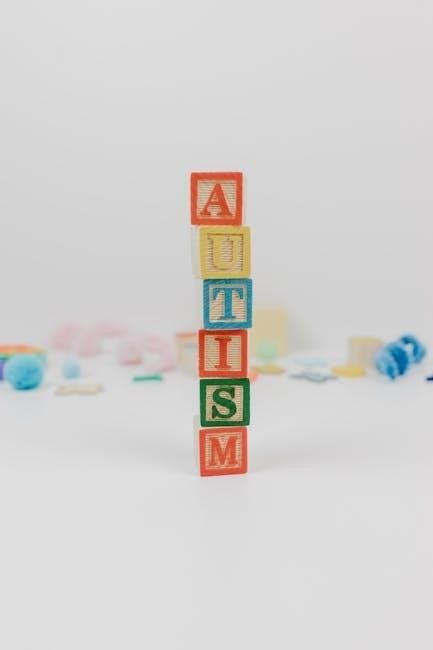
Occupational therapy is a client-centered approach addressing daily living skills, social interactions, and sensory challenges in autism, tailored to individual needs and evidence-based practices.
Definition and Role of Occupational Therapy in Autism Management
Occupational therapy (OT) is a client-centered, evidence-based practice that focuses on enabling individuals with autism to achieve independence in daily activities, social interactions, and sensory regulation. Occupational therapists assess and address barriers to participation in meaningful occupations, such as self-care, play, and education. Their role involves collaborating with families, caregivers, and other professionals to design interventions tailored to the individual’s needs and priorities. OT emphasizes functional outcomes, promoting skills for everyday living and enhancing overall quality of life. By addressing sensory, motor, and adaptive challenges, occupational therapists play a pivotal role in supporting individuals with autism to thrive in their natural environments.
Overview of Occupational Therapy Interventions for Autism Spectrum Disorder (ASD)
Occupational therapy interventions for ASD focus on enhancing daily living skills, sensory processing, and social participation. They are tailored to address individual needs, incorporating strategies like sensory integration, motor skills development, and adaptive techniques. Interventions often occur in natural settings, such as homes or schools, to promote functional outcomes. Occupational therapists use evidence-based practices to support children in achieving independence in self-care, play, and academic activities. These interventions also emphasize collaboration with parents and caregivers to ensure consistency and carryover in daily routines. By addressing sensory, motor, and adaptive challenges, OT interventions aim to improve overall participation and quality of life for individuals with ASD, fostering their ability to engage meaningfully in their environments.

Key Occupational Therapy Interventions for Autism
Key occupational therapy interventions for autism include sensory integration, motor skills development, adaptive strategies, and social skills training to improve daily participation and overall well-being.

Sensory Integration Therapy
Sensory integration therapy is a widely used occupational therapy intervention for autism, focusing on improving how individuals process sensory information. It helps manage sensory overload, enhance sensory processing, and promote adaptive responses to environmental stimuli. Techniques include exposing individuals to controlled sensory experiences, such as tactile, vestibular, or proprioceptive activities, to regulate and integrate sensory input. Research, such as studies by Rodger (2010a) and Tomchek et al., highlights its effectiveness in reducing sensory-related challenges and improving motor skills in children with autism. While some studies show mixed results, sensory integration therapy remains a key component of occupational therapy, offering tailored strategies to support individuals with autism in navigating their sensory environment more effectively. This approach is often combined with other interventions for comprehensive care.
Motor Skills Development
Motor skills development is a critical component of occupational therapy for autism, focusing on improving fine and gross motor abilities. Occupational therapists design activities to enhance coordination, balance, and dexterity, which are essential for daily tasks like writing, dressing, and play. Research, such as studies by Rodger (2010a) and Tomchek et al., emphasizes the importance of motor planning and praxis skills in children with autism. Interventions often include tactile exercises, adaptive tools, and structured physical activities to address specific motor challenges. These strategies aim to promote independence, confidence, and participation in age-appropriate activities. By addressing motor deficits, occupational therapy helps individuals with autism achieve functional skills that enhance their overall quality of life and engagement in meaningful occupations.
Adaptive Strategies for Daily Living
Occupational therapy emphasizes adaptive strategies to enhance daily living skills for individuals with autism, fostering independence in self-care and routine tasks. Interventions focus on breaking down complex activities, such as eating, dressing, and grooming, into manageable steps. Visual supports, sensory-friendly tools, and structured routines are commonly used to facilitate mastery. Therapists also address environmental modifications to reduce sensory sensitivities and improve task performance. Adaptive strategies are tailored to each individual’s needs, ensuring they align with personal goals and preferences. These interventions not only enhance functional abilities but also boost confidence and participation in daily life, ultimately improving overall quality of life and well-being for individuals with autism.
Social Skills Development
Occupational therapy plays a vital role in enhancing social skills for individuals with autism, addressing challenges in communication and interaction. Therapists use structured activities, role-playing, and social stories to teach appropriate social behaviors. Group sessions encourage collaboration and peer interaction, fostering empathy and understanding. Visual supports, such as social scripts, help individuals navigate complex social situations. Interventions are tailored to each person’s needs, focusing on initiating and maintaining conversations, interpreting nonverbal cues, and developing friendships. These strategies aim to reduce social anxiety and improve participation in group settings, enhancing overall social competence and confidence. By addressing these skills, occupational therapy empowers individuals with autism to engage more effectively in their social environments.
Parent and Caregiver Involvement
Active involvement of parents and caregivers is crucial in occupational therapy for autism, ensuring consistency and carryover of skills into daily life. Therapists collaborate with families to identify priorities and develop personalized strategies, fostering a supportive environment. Education on techniques like sensory integration and adaptive strategies empowers caregivers to support their child’s development. Home programs and resource sharing enable parents to reinforce therapeutic goals, promoting continuity. This partnership enhances the child’s progress and strengthens the caregiver’s confidence in addressing their child’s needs. By integrating caregiver involvement, occupational therapy maximizes the child’s potential and fosters meaningful participation in family and community activities.

Assessment and Goal Setting in Occupational Therapy for Autism
Occupational therapy begins with comprehensive assessments to identify strengths, challenges, and priorities. Goals are tailored to enhance functional abilities, ensuring measurable outcomes aligned with individual and family needs.

Assessment Tools and Methods
Occupational therapists use standardized assessments like the Sensory Integration and Praxis Tests (SIPT) and the Assessment of Motor and Process Skills (AMPS) to evaluate sensory, motor, and adaptive abilities. These tools help identify strengths and challenges, guiding intervention planning. Observations in natural settings, such as homes or schools, provide insights into daily functioning. Parent and caregiver input is crucial for understanding the individual’s routines and priorities. Assessments may also include the Vineland Adaptive Behavior Scales to measure daily living skills. The goal is to gather comprehensive data to inform personalized therapy plans, ensuring interventions address the unique needs of each individual with autism. This collaborative approach supports meaningful goal setting and effective outcomes.
Setting Functional and Measurable Goals
Occupational therapists work collaboratively with individuals, parents, and caregivers to set functional and measurable goals tailored to the person’s needs and priorities. These goals are designed to enhance daily living skills, social participation, and independence. They are specific, achievable, and aligned with the individual’s occupational priorities, ensuring relevance and focus. For example, goals may target improvements in self-care routines, communication, or classroom participation. Regular progress monitoring and adjustments are made to ensure goals remain relevant and achievable. This collaborative approach ensures therapy is person-centered and focused on meaningful outcomes, promoting long-term independence and quality of life for individuals with autism.

Effectiveness of Occupational Therapy Interventions
Research highlights the effectiveness of occupational therapy in improving motor skills, sensory integration, and daily functioning for individuals with autism, supported by evidence-based interventions.
Research Findings on Sensory Integration and Motor Skills
Research demonstrates that occupational therapy interventions focusing on sensory integration and motor skills development can significantly benefit individuals with autism. Studies highlight improvements in sensory processing, motor planning, and praxis skills, which are essential for daily functioning and play. For instance, sensory integration therapy has shown mixed results, with some studies indicating enhanced sensory processing and others finding limited evidence of its efficacy. However, motor skills development interventions consistently report positive outcomes, particularly in fine motor activities and goal-oriented tasks. These findings underscore the importance of tailored interventions that address both sensory and motor challenges, fostering greater independence and participation in daily activities. Combining sensory integration with motor skills training often yields more comprehensive results, emphasizing the need for a holistic approach in occupational therapy for autism.
Outcome Measures and Success Stories
Occupational therapy interventions for autism have demonstrated measurable outcomes, with success stories highlighting improved daily living skills and social interactions. Standardized assessments and functional outcome measures, such as goal attainment scaling, are widely used to evaluate progress. Many studies report significant improvements in sensory processing, motor skills, and adaptive behaviors following targeted interventions. Parents and caregivers often share anecdotal evidence of enhanced independence, reduced sensory sensitivities, and increased participation in daily activities. For instance, children who struggled with self-care tasks like dressing or feeding showed marked improvement after sensory integration and motor skills training. These success stories underscore the long-term benefits of occupational therapy in fostering independence and quality of life for individuals with autism.

Technology and Innovation in Occupational Therapy for Autism
Technology enhances traditional OT methods, offering virtual reality, telehealth, and digital tools to improve accessibility and engagement for individuals with autism, ensuring personalized and effective interventions.
Use of Assistive Technology
Assistive technology plays a crucial role in occupational therapy for autism, providing individuals with tools to overcome challenges in communication, sensory processing, and daily tasks. Devices such as speech-generating devices, weighted vests, and adaptive utensils are commonly used to enhance independence. These technologies are tailored to individual needs, helping individuals with autism navigate their environments more effectively. For instance, wearable devices can offer tactile input to regulate sensory experiences, while apps and software can assist with social skills and emotional regulation. The integration of assistive technology not only fosters independence but also promotes participation in meaningful activities, aligning with the client-centered goals of occupational therapy. By leveraging these tools, occupational therapists can create personalized interventions that address specific needs and improve overall quality of life.
Digital Tools for Therapy Interventions
Digital tools are increasingly being integrated into occupational therapy for autism, offering innovative ways to support skill development and engagement. Apps, software, and virtual reality (VR) platforms provide interactive environments for practicing social interactions, emotional regulation, and motor skills. These tools often include customizable activities that cater to individual needs, making therapy more accessible and engaging. For example, VR can simulate real-life scenarios to help individuals with autism practice social interactions in a controlled setting. Digital tools also enable remote therapy sessions, expanding access to care, especially in underserved areas. By leveraging technology, occupational therapists can create dynamic, personalized interventions that enhance learning and participation in daily activities, fostering greater independence and confidence for individuals with autism.

Cultural Competence and Occupational Therapy Practice

Cultural competence in occupational therapy ensures respectful, effective interventions tailored to diverse cultural values, enhancing collaboration with families and improving outcomes for individuals with autism.
Culturally Responsive Interventions
Culturally responsive interventions in occupational therapy for autism involve adapting strategies to align with the individual’s and family’s cultural values, beliefs, and practices. Occupational therapists must recognize and respect diverse cultural perspectives to ensure effective and meaningful support. This includes incorporating culturally relevant activities and tools into therapy sessions. Collaboration with families and caregivers is essential to understand their unique needs and preferences. By embracing cultural humility, therapists can foster trust and engagement, ensuring interventions are both respectful and effective. These practices promote inclusivity and empower individuals with autism to thrive within their cultural contexts, enhancing overall well-being and participation in daily life. Such approaches are critical for equitable and person-centered care.
Addressing Diversity in Therapy Settings
Addressing diversity in therapy settings is crucial for ensuring inclusive and effective occupational therapy interventions for autism. Occupational therapists must be culturally competent, adapting their practices to meet the unique needs of individuals from diverse backgrounds. This involves understanding and respecting differences in cultural values, beliefs, and practices that may influence engagement and outcomes. Therapists should collaborate with families and caregivers to incorporate culturally relevant activities and strategies. Additionally, therapy environments should be inclusive, ensuring accessibility for individuals of all abilities and backgrounds. By embracing diversity, occupational therapists can foster trust and improve participation in therapy, ultimately enhancing the effectiveness of interventions for autistic individuals across varied cultural and socio-economic contexts.

Future Directions in Occupational Therapy for Autism
Future directions in occupational therapy for autism focus on early intervention, personalized strategies, and integrating technology like telehealth and VR for enhanced accessibility and engagement, fostering collaboration across disciplines.
Emerging Trends and Practices
Emerging trends in occupational therapy for autism emphasize early intervention, personalized strategies, and the integration of technology such as telehealth and virtual reality (VR). These innovations enhance accessibility and engagement, particularly for individuals with diverse needs. There is a growing focus on sensory integration techniques combined with adaptive strategies to improve daily living skills. Additionally, the use of AI-driven tools for assessment and intervention is gaining traction, allowing for more precise and tailored approaches. Collaborative practices between occupational therapists and other disciplines, such as psychology and speech therapy, are also being prioritized to create comprehensive care plans. These advancements aim to address the unique challenges of autism, fostering independence and improving overall quality of life for individuals across the spectrum.
Collaboration with Other Therapeutic Disciplines
Collaboration between occupational therapy and other disciplines, such as speech therapy, psychology, and physical therapy, is essential for comprehensive care in autism management. This interdisciplinary approach ensures a balanced intervention that addresses diverse needs, including communication, emotional regulation, and motor skills. Occupational therapists work closely with psychologists to develop strategies for emotional well-being and social interactions. Similarly, collaboration with speech therapists enhances communication goals, while physical therapists assist with motor development. Together, these professionals create a cohesive plan tailored to the individual’s needs, fostering a holistic approach to therapy. This teamwork not only improves functional outcomes but also supports the overall well-being of individuals with autism, ensuring a coordinated and effective intervention process.

